Related Research Articles

The Fantasy Trip (TFT) is a fantasy tabletop role-playing game designed by Steve Jackson and published in segments by Metagaming Concepts starting in 1977 and culminating in 1980. In 2019, Steve Jackson Games republished it as The Fantasy Trip Legacy Edition.

A wargame is a strategy game in which two or more players command opposing armed forces in a simulation of an armed conflict. Wargaming may be played for recreation, to train military officers in the art of strategic thinking, or to study the nature of potential conflicts. Many wargames re-create specific historic battles, and can cover either whole wars, or any campaigns, battles, or lower-level engagements within them. Many simulate land combat, but there are wargames for naval, air combat, and cyber as well as many that combine various domains.

Talisman: The Magical Quest Game is a fantasy-themed adventure board game for two to six players, originally designed and produced by Games Workshop. The game was first released in 1983 and has gone through three revisions. As of 2024, the fifth edition (2024) is the latest version. The board game sold over 800,000 units by 2000.
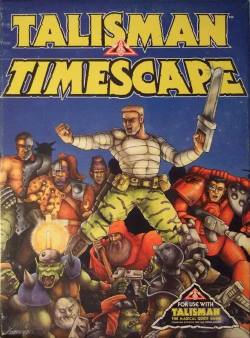
Talisman Timescape is a 1988 expansion for the second edition of the fantasy board game Talisman, both produced by Games Workshop (GW).

Cosmic Encounter is a science fiction–themed strategy board game designed by "Future Pastimes" and originally published by Eon Games in 1977. In it, each player takes the role of a particular alien species, each with a unique power to bend or break one of the rules of the game, trying to establish control over the universe. The game was inducted into the Academy of Adventure Gaming Arts & Design Adventure Gaming Hall of Fame in 1997.

HeroQuest, is an adventure board game created by Milton Bradley in conjunction with the British company Games Workshop in 1989, and re-released in 2021. The game is loosely based around archetypes of fantasy role-playing games: the game itself was actually a game system, allowing the gamemaster to create dungeons of their own design using the provided game board, tiles, furnishings and figures. The game manual describes Morcar/Zargon as a former apprentice of Mentor, and the parchment text is read aloud from Mentor's perspective. Several expansions have been released, each adding new tiles, traps, artifacts, and monsters to the core system.

Lord of the Rings is a cooperative board game based on the high fantasy novel The Lord of the Rings by J. R. R. Tolkien. Published in 2000 by Kosmos in Germany, Wizards of the Coast in the U.S., and Parker Brothers in the U.K., the game is designed by Reiner Knizia and features artwork by illustrator John Howe. In the game, each player plays a hobbit in the party, and the party will aim to destroy the One Ring. Upon its release, the game received a Spiel des Jahres special award. A slightly revised version was later published by Fantasy Flight Games.

Magic Realm is a fantasy adventure board game designed by Richard Hamblen and published by Avalon Hill in 1979. Magic Realm is more complex than many wargames and is somewhat similar to a role-playing game. It can be played solitaire or with up to 16 players and game time can last 4 hours or more. The game board is a type of geomorphic mapboard constructed of large double-sided hexagon tiles, ensuring a wide variety of playing surfaces.

Scorpion Swamp is a single-player adventuring gamebook written by Steve Jackson, illustrated by Duncan Smith, and originally published in 1984 by Puffin Books. It forms part of Steve Jackson and Ian Livingstone's Fighting Fantasy series. It is the 8th in the series in the original Puffin series (ISBN 0-14-031829-1). It was the first Fighting Fantasy book not written by the series' co-creators.

Divine Right is a fantasy board wargame designed by brothers Glenn A. Rahman and Kenneth Rahman. The game was first published in 1979 by TSR, Inc., and a 25th Anniversary Edition was published in 2002 by The Right Stuf International.

Dungeon! is an adventure board game designed by David R. Megarry and first released by TSR, Inc. in 1975. Additional contributions through multiple editions were made by Gary Gygax, Steve Winter, Jeff Grubb, Chris Dupuis and Michael Gray. Dungeon! simulates some aspects of the Dungeons & Dragons (D&D) role-playing game, which was released in 1974, although Megarry had a prototype of Dungeon! ready as early as 1972.
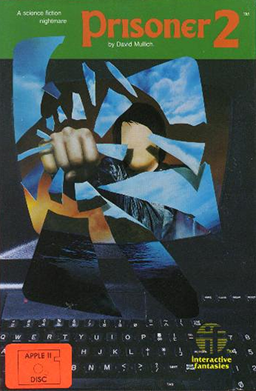
The Prisoner 2 is a video game published in 1982 by Edu-Ware. It is a remake of the 1980 game The Prisoner.
BattleLore is a strategy board wargame for two players, created by Richard Borg and initially published by Days of Wonder in 2006. The game is based on the same mechanics as Battle Cry, Memoir '44 and Commands & Colors: Ancients, but has a fantasy and medieval theme.
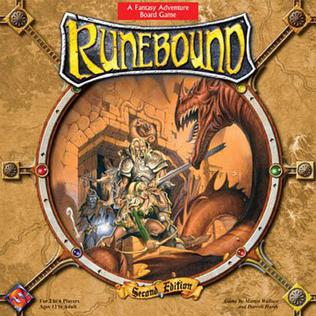
Runebound is a high fantasy adventure board game created by Martin Wallace and Darrel Hardy and published by Fantasy Flight Games in 2004. A second edition was published in 2005. A third edition was released in 2015. In Runebound, one to six players take the roles of adventurers who seek out quests. The quests are then resolved with either victory for the player, or a loss of some item. Each player is seeking quests and trying to gain experience which results in greater power and combat skill.

The Sorcerer's Cave is a fantasy board/card game designed by Terence Peter Donnelly and first published in 1978. Though greatly simplified, it was inspired by the fantasy role-playing game Dungeons & Dragons. Unlike D&D, however, Sorcerer's Cave does not require "Dungeon Master" or referee. One of its strengths is that it can be played solo or competitively, as well as cooperatively. Another is the diplomatic aspect of interactions between players with changing agendas. In general, player(s) gather and control a party of adventurers who explore a multi-level dungeon that is randomly generated by drawing area cards from a deck. Encounters include special rooms, traps, monsters, allies, magical items and treasures.

The Lord of the Rings: The Card Game is a card game produced by Fantasy Flight Games since 2011. As part of the Living Card Game (LCG) genre, it is a cooperative and strategic card game set in Middle-earth, a fantasy world featured in literary works by J. R. R. Tolkien, including The Hobbit and The Lord of the Rings.
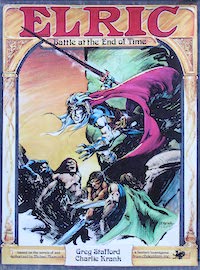
Elric: Battle at the End of Time is a board wargame published by Chaosium in 1982, an update of the 1977 game simply titled Elric. It is based on the Elric of Melniboné books by Michael Moorcock. There have been three English language editions, Elric (1977), Elric: Battle at the End of Time (1982), and Elric (1984), published by Avalon Hill.

Swords & Sorcery, subtitled "Quest and Conquest in the Age of Magic", is a fantasy-themed board wargame published by Simulations Publications, Inc. (SPI) in 1978.
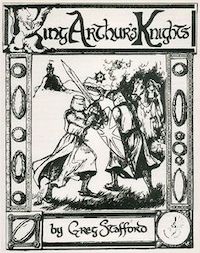
King Arthur's Knights is an Arthurian board game published by Chaosium in 1978 in which knights of the Round Table perform chivalrous quests for artifacts and treasure.
References
- ↑ Sacco, Ciro Allessandro. "An Interview with Dave Arneson". Archived from the original on July 7, 2004. Retrieved June 3, 2009. (Alternative URL: .)
- ↑ St. Andre, Ken (1985). "Batsignals". TNT Zine (17–18): 1 – via Tunnels & Trolls Treasury.
- ↑ Lombardy, Dana (January 1984). "Gaming". Asimov's Science Fiction . 8 (1): 24–26 – via Internet Archive.
- 1 2 Costello, Matthew (January 1984). Schmittberger, R. Wayne (ed.). "Games & Books; Pentantastar". Games (47). Playboy Enterprises: 54 – via Internet Archive.
- ↑ "Games 100; Fantasy Worlds". Games (57). Playboy Enterprises: 44. November 1984 – via Internet Archive.